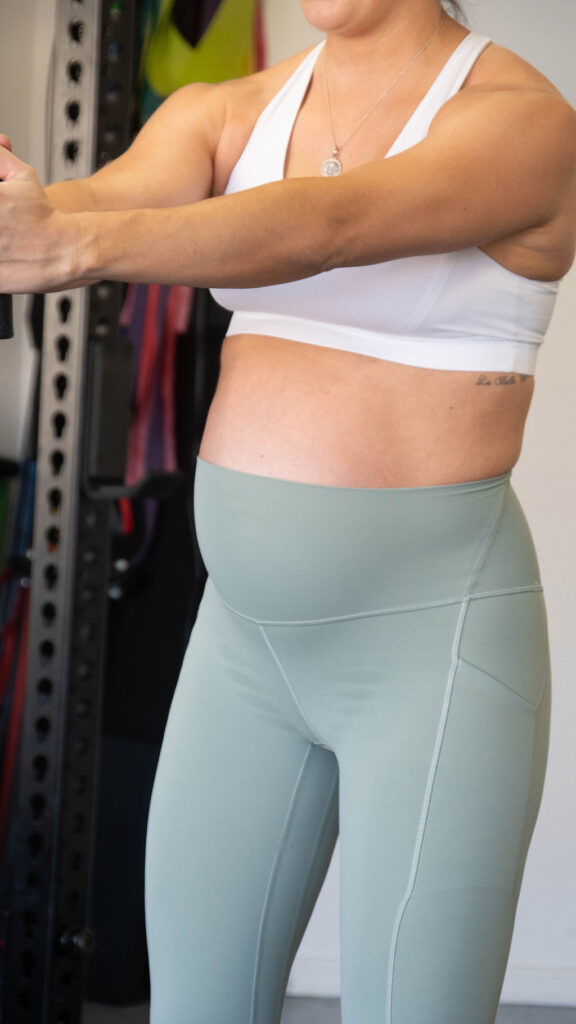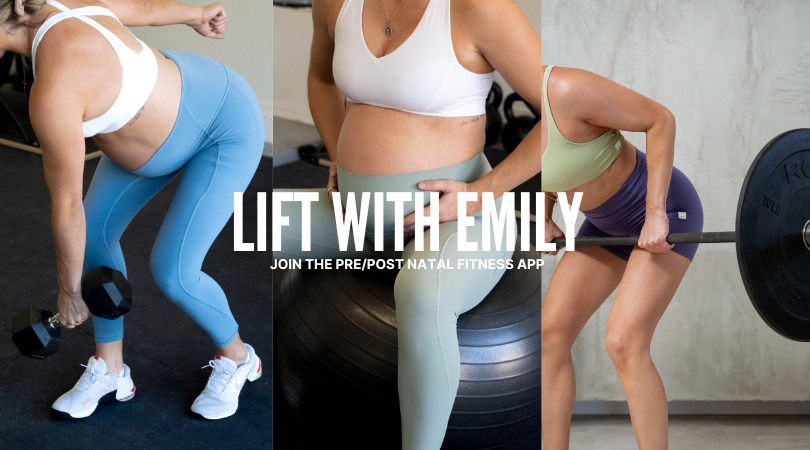The core connection you didn’t know you needed in pregnancy and postpartum: strengthening your oblique slings.
When we talk about “core strength” during pregnancy and postpartum most people think about planks, breathing, or deep core rehab exercises. And while those matter, there’s one powerful part of your core that often gets overlooked – the oblique sling systems.

These sling systems play a huge role in everything from pelvic stability to pressure management, and are essential for healing, feeling strong, and reducing pain in motherhood.
Let’s break them down and show you exactly how to train them.
What are the anterior and posterior oblique slings?
Your core isn’t just one group of muscles. It’s a system of connections. The oblique slings are muscular chains that wrap diagonally across your body and link your upper body to your lower body. They work across the front and back of your body to create rotational power, stability, and coordination.
Anterior oblique sling
This sling includes:
- External oblique (side of your core)
- Opposite side internal oblique
- Adductors (inner thigh muscles)
These muscles work together for movements like walking, rotating, and bracing. They also help manage intra-abdominal pressure, which is essential for supporting your pelvic floor, assist in rotation and anti rotation, as well as pelvic stability during load transfer.

Posterior oblique sling
This sling includes:
- Latissimus dorsi (upper back)
- Opposite side glute max
- Thoracolumbar fascia (connective tissue in your low back)
This chain helps with pelvic stability, hip extension, and controlling force transfer during daily movement and lifting. It’s also crucial for supporting the sacroiliac (SI) joint and reducing pain in the low back, hips, or pelvis. This also plays a big role in gait, lifting and posture as well as the transfer of force between the upper and lower body.
Why this matters during pregnancy
During pregnancy, your growing belly shifts your center of gravity, affects your posture, and stretches your core. Your pelvis becomes more mobile to prepare for birth and that means your body has to work harder to stay stable.
Strengthening your oblique sling systems during pregnancy can help:
- Improve balance and coordination: these slings support your ability to walk, lift, and move efficiently while maintaining spinal and pelvic alignment.
- Reduce low back or SI joint pain: strong, coordinated sling systems help distribute force more evenly across the body, reducing discomfort.
- Minimize strain on your pelvic floor: activating the obliques, glutes, and adductors helps regulate intra-abdominal pressure, making it easier to manage load and reduce strain on your pelvic floor.
- Prepare your body for the rotational and pushing demands of labor: from rolling in bed to rotating during labor, sling strength supports rotational strength and mobility – key for functional tasks and birth positions.
Why this matters postpartum
After birth, you might feel disconnected from your core, weaker, or unstable. These slings help restore that cross-body coordination, rebuild core tension, and reduce symptoms like:
- Leaking
- Pelvic heaviness
- Abdominal separation (diastasis recti)
- Hip, back, or SI joint pain
Rebuilding strength in these systems also supports more dynamic, full-body strength—exactly what you need for motherhood.
Strengthening your oblique sling systems during the postpartum period can help:
- Restore core integrity + coordination: after pregnancy, many moms feel “disconnected” from their core. Training the slings rebuilds neuromuscular coordination across the anterior + posterior chains.
- Rebuild cross-body strength: your everyday mom life includes carrying a baby on one side, rotating, lifting, twisting – all of which depend on strong slings.
- Support pelvic floor + diastasis healing: sling engagement helps offload pressure from the pelvic floor and improves tension through the linea alba, supporting abdominal tissue healing.
- Prevent injury + support return to impact: before jumping back into running, HIIT, or strength training, sling function provides the foundation for efficient, resilient movement.
How to train your oblique slings
Here are 7 of my favorite exercises that target both your anterior and posterior slings. Each one layers in breath, core, and full-body strength:
Crunch with Diagonal Pulldown
Sling focus: Anterior oblique sling
Muscles: External obliques, deep core (TA), pecs, and opposite-side hip flexors
Why it helps: This exercise strengthens the connection between the upper and lower body via the diagonal anterior sling, promoting core coordination and tension management postpartum. It’s especially beneficial for re-integrating the abdominal wall and improving cross-body core activation.
Postpartum benefit: Re-establishes core coordination after pregnancy, especially where there has been abdominal separation (diastasis recti). It challenges the deep core in a controlled, functional way.
How to perform:
- Lie on your back with knees bent, feet flat, and a light weight in one hand.
- As you exhale, perform a small crunch and pull the cable diagonally across the body toward the opposite knee.
- Keep your ribs down and core engaged, avoiding bulging or doming.
- Lower with control and repeat before switching sides.
Inverted Row with Hip Flexion
Sling focus: Posterior oblique sling
Muscles: Lat, glute max, thoracolumbar fascia, hip flexors, core stabilizers
Why it helps: when hip flexion is incorporated, it emphasizes the connection between the back and glutes, engaging the posterior oblique sling. This improves upper and lower body integration, spinal stability, and rotational control.
Pregnancy & postpartum benefits: helps train the core to stay active during upper body pulling movements. Supports pelvic and lumbar stability, especially beneficial in postpartum reconditioning.
How to perform:
- Set up under a TRX or bar at waist height.
- Start in a horizontal row position with knees bent and hips lifted.
- As you row, lift one knee toward your chest, engaging your core.
Side Lying Hip Lift with Cable Row
Sling focus: Posterior oblique sling
Muscles: Glutes, hamstrings, lats, obliques
Why it helps: this unilateral movement challenges the glutes and lats in a cross-body pattern, strengthening the posterior sling, which is essential for gait and rotational power.
Pregnancy & postpartum benefits: improves lateral pelvic stability and supports functional glute engagement, both key during pregnancy and for postpartum return to dynamic movement.
How to perform:
- Lie on your side, knees bent, legs together
- Press through your bottom knee and lift your hips off the ground, opening your top leg away from your mid line
- As you lift, simultaneously perform a cable or band row with the top arm, pulling toward your ribcage.
- Keep hips stacked and avoid rotating.
Hamstring Bridge with Single Arm Isometric Pulldown
Sling focus: Posterior oblique sling
Muscles: Hamstrings, glutes, lats, deep core
Why it helps: this exercise integrates the posterior sling by combining lower body extension with resisted upper body stabilization, improving cross-body tension and control.
Pregnancy & postpartum benefit: safe in pregnancy and helpful postpartum to re-engage the glutes, hamstrings and lats while stabilizing the core. Encourages full-body tension without spinal strain.
How to perform:
- Lie on your back with feet on a bench or elevated surface, knees bent.
- Hold a band or cable overhead with one arm.
- Bridge up by driving through the heels, and simultaneously pull down with the arm to create isometric tension.
- Hold both the hip extension and cable for 5-8 seconds before lowering back to the ground with control
Landmine Single Leg Deadlift
Sling focus: Posterior oblique sling
Muscles: Glutes, hamstrings, lats, core stabilizers
Why it helps: trains contralateral glute and lat activation, mimicking the force transfer needed in walking, running, and lifting. Adds stability challenge with the landmine arc.
Pregnancy & postpartum benefit: promotes balance, single-leg stability, and glute re-engagement -great for rebuilding strength postpartum or maintaining it through pregnancy (modify range if needed).
How to perform:
- Hold the landmine with the opposite hand of your stance leg.
- Hinge at the hips, extending the non-working leg behind you.
- Keep hips square and spine neutral.
- Lower barbell towards the ground, feeling your glutes lengthen and open
- Return to standing with control and repeat.
Bird Dog Pulldown
Sling focus: Posterior oblique sling
Muscles: Lats, glutes, spinal stabilizers
Why it helps: combines contralateral glute and lat activation in a prone position that mimics crawling or gait. Great for improving coordination, core tension, and anti-rotation.
Pregnancy & postpartum benefit: low-load, full-body engagement ideal for postpartum reconditioning. Improves core control, especially against rotational forces. This is a great one if you are experiencing any SI joint pain during pregnancy.
How to perform:
- In a all fours position, hold a band or cable in one hand.
- Pull the band down toward your waist while as you simultanously extend the opposite leg and keep hips level.
- Maintain tension through the core and glutes
- Return and repeat.
Deadbug with Cross Connect
Sling focus: Anterior oblique sling
Muscles: Core stabilizers, hip flexors, obliques, shoulder stabilizers
Why it helps: this cross-body core drill strengthens diagonal patterns that stabilize the pelvis and spine. The press into the opposite knee activates the sling system and enhances core engagement.
Pregnancy & postpartum benefit:
Postpartum: retrains deep core and sling coordination with minimal pressure on the abdominal wall.
Late pregnancy: may not be suitable and can be modified or avoided if doming occurs.
How to perform:
- Lie on your back with knees and hips at 90°.
- Press your right hand into your left knee.
- Slowly lower your right leg and left arm, keeping core tight and ribs down.
- Return and repeat before switching sides.
Final thoughts
You don’t need to “guess” which core exercises are safe in pregnancy or postpartum. When you understand the why behind movement and focus on restoring these cross-body connections – you build lasting strength from the inside out.
And the best part? These patterns are already built into our Lift with Emily App workouts – designed specifically for pregnant and postpartum women.
🎥 Want to see these exercises in action?
Start your 7-day free trial inside the Lift with Emily App and get:
- Immediate access to strength-based workouts
- Programming that meets you where you’re at
- A community of women just like you
- Video demos and coaching tips for every move
👉 Click here to try the LWE App free for 7 days

I’m deeply passionate about helping women feel strong, informed, and confident through every stage of motherhood. You deserve more than just a list of do’s and don’ts or generic modifications. With years of hands-on coaching across all kinds of athletes and clients, I blend real-world experience with specialized pre and postnatal knowledge to create strength programs that go far beyond basic adjustments. This is high-level, accessible training - built for your body, your season, and your goals
EXPLORE MORE POSTS